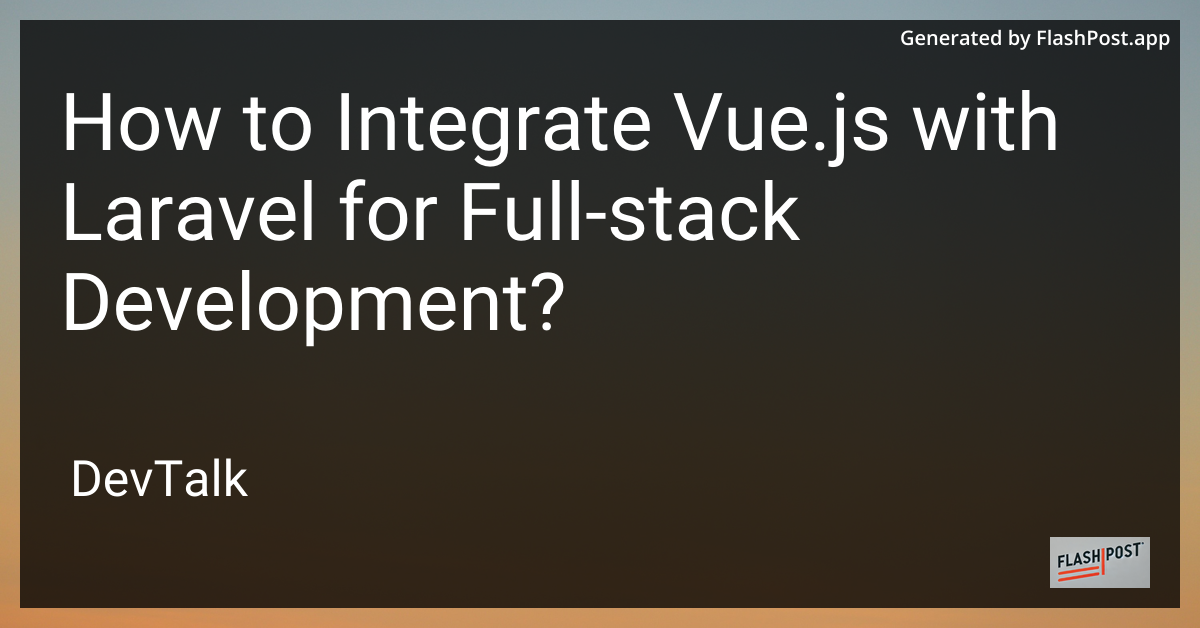How to Integrate Vue.js with Laravel for Full-stack Development?

How to Integrate Vue.
js with Laravel for Full-Stack Development
In the ever-evolving landscape of web development, the ability to create seamless full-stack applications is a highly sought-after skill. Combining the powerful capabilities of Vue.js and Laravel offers a versatile solution for developers looking to build robust web applications. This guide will walk you through the process of integrating Vue.js with Laravel, resulting in an efficient and reactive full-stack application.
Why Choose Vue.js and Laravel?
Vue.js is a progressive JavaScript framework that is designed to build user interfaces. It is approachable, versatile, and provides a core library that focuses on the view layer alone, making it an excellent choice for front-end development.
Laravel, on the other hand, is a rich PHP framework known for its elegant syntax, robust tools, and its ability to facilitate MVC architecture. It provides a strong backend structure that simplifies the complexities of routing, sessions, caching, and more.
Combining Vue.js with Laravel can significantly enhance the performance and interactivity of your full-stack applications while maintaining a clean and manageable codebase.
Setting Up Your Laravel Environment
To get started with integrating Vue.js into your Laravel application, you need to set up a Laravel environment.
-
Install Laravel: If you haven't installed Laravel yet, use Composer to install a new Laravel project:
composer create-project --prefer-dist laravel/laravel vue-laravel-app -
Set Up a Database: Update the
.envfile with your database credentials to ensure Laravel can interact with your database. -
Migrate Your Database: Run Laravel migrations to set up your database schema:
php artisan migrate
Integrating Vue.js
Laravel comes with built-in support for Vue.js. Here's how you can integrate Vue.js into your Laravel application:
-
Install Node.js and NPM: Ensure Node.js and NPM are installed in your environment. You will need these to install Vue.js and other dependencies.
-
Install Vue.js: Within your Laravel application root directory, run the following command:
npm install vue --save -
Configure Webpack: Laravel Mix is a clean layer on top of Webpack to provide a fluent API for defining modern JavaScript builds:
-
Open
resources/js/app.jsand include Vue:require('./bootstrap'); window.Vue = require('vue'); const app = new Vue({ el: '#app', }); -
Run the following command to compile your assets:
npm run dev
-
-
Create Vue Components: You can create reusable Vue components within the
resources/js/components/directory. Here's an example of creating a simple component:Vue.component('example-component', require('./components/ExampleComponent.vue').default); -
Integrate Vue.js Components in Laravel Views: Use your Vue components within Laravel Blade files. For example, add the component to a view:
<div id="app"> <example-component></example-component> </div>
Additional Vue.js Resources
Enhance your Vue.js capabilities with these useful resources:
- Learn how to integrate powerful text editors in Vue.js: Vue.js Text Editor Integration
- Master the use of the ternary operator in Vue.js: Ternary Operator in Vue.js
- Discover how to create and integrate Vue.js components: Vue.js Component
- Understand how to manage checkboxes within Vue.js: Vue.js Checkbox
- Find out how to pass arrays into iframe elements using Vue.js: Vue.js Array Passing
Conclusion
Integrating Vue.js with Laravel harnesses the powerful features of both frameworks, resulting in highly interactive, efficient, and maintainable full-stack applications. From dynamic front-end interfaces to a robust backend architecture, this combination is ideal for modern web development needs. With the resources and steps outlined above, you're well on your way to mastering full-stack development with Vue.js and Laravel.